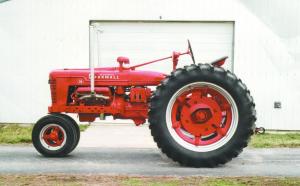2015 - Volume #39, Issue #4, Page #20
[ Sample Stories From This Issue | List of All Stories In This Issue | Print this story
| Read this issue]
Farmall H Repowered With IH V-8 Truck Engine
 |
The tractor rides on new Firestone 13.6 by 38 tires on back and 6.00 by 16 tires on front. It has a custom automotive paint job, new decals, custom lights, and a tachometer. Latimer painted the engine red, added a chrome breather and accessories, and painted the wheel rims with automotive silver.
“Even though it has a truck engine, it’s still an all-IH tractor,” says Latimer. “The new engine has 8 cylinders and exactly twice as many cu. in. as the original one. You can see the valve covers sticking out from under the hood, but people don’t realize what the entire engine looks like until I lift the hood and they see the chrome breathers and trim.”
Latimer already had the engine, which he bought as a backup for his combine. “I needed to sell it or do something with it, so I decided to buy a 1940 Farmall with a burned-out engine for $200 from my cousin,” he says.
He wanted to keep the tractor looking as natural as possible and close to its original length, so he set the engine as far back as he could. “The tractor is only 2 7/8 in. longer than before, so when I bring it to shows most people don’t even notice the difference,” he says.
He started out by splitting the tractor in half. The new 8-cyl. engine was wider than the original 4-cyl. so he split two different sets of frame rails, “V”ing them toward the back and bringing them out to the side far enough to make room for the engine. He also had to lengthen the steering shaft and the hood.
Latimer kept the tractor’s original flywheel, clutch, and pressure plate. He cut down the flywheel on back of the engine and built an adapter bracket to attach the flywheel to it. He made a 3/4-in. thick adapter plate and installed it at the back of the rails to help support the weight of the big engine. A local shop made an adapter plate to connect the engine to the transmission. He also installed an electric fuel pump and a remote spin-on oil filter under the engine.
“I made a lot of careful measurements to make sure everything lined up before I built it, so I spent a lot of time taking things apart and putting them back together before I got everything to work right,” he says.
He turned the engine’s original exhaust manifolds upside down, then built a set of straight pipes out of galvanized exhaust tubing with weather caps.
“The engine sounds mellow and doesn’t make a lot of noise. People can’t believe how smooth it runs,” says Latimer. “I made a lot of changes to the back of the crankshaft so I had the shop externally balance the engine so it wouldn’t shake itself apart. If I lay my hand on the side of the tractor, I can hardly feel any vibration at all,” he notes.
Contact: FARM SHOW Followup, Larue Latimer, 7874 Hwy. F., Hartville, Mo. 65667 (ph 417 741-6340; pam.latimer210@gmail.com).

Click here to download page story appeared in.

Click here to read entire issue
To read the rest of this story, download this issue below or click here to register with your account number.




